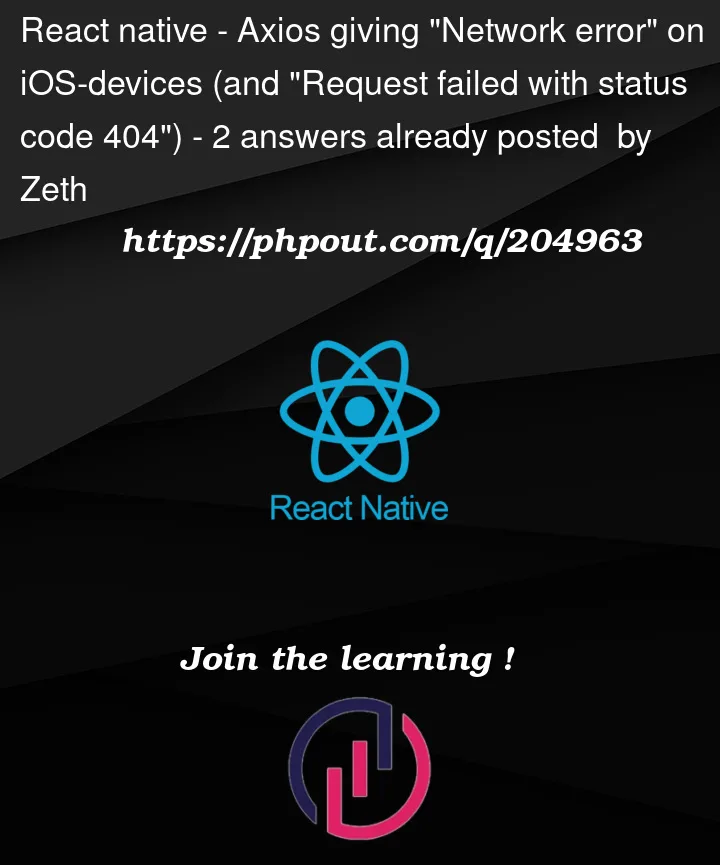I’m having a bug on iOS devices. All requests to my API fails with either the error Network Error or Request failed with status code 404. I tried a bunch of things to debug it.
More context
- The app is written in React Native and Expo
- The API is built using Node.JS and TypeScript.
- The API is running on my own little VPS (on an Nginx-server, served on port :8080, so not via HTTPS).
- Axios requests works in an iOS simulator (on my Mac).
- Axios requests are not working (errors being: ‘Network Error’ or ‘Request failed with status code 404’) when I run it on my phone.
- Axios requests are not working when I try my app from the Expo Go-app on my phone.
- I deploy my app using
eas buildfollowed byeas submit).
What baffles me, is that I don’t know why or where it fails.
Solution attempt 1: Upgrade Expo SDK
I tried upgrading from version 48 to 49. This gave me all kinds of other issues – and the Axios error persisted. So I downgraded again to version 48 (version 49 had only been out for 3 days).
Solution attempt 2: Check tcpdump on my server
I checked on my server if it’s being hit at all using: sudo tcpdump -i any port 8080. And I didn’t get anything, when I got the Axios errors.
So I could conclude that the error was before it hit the server.
Solution attempt 3: Implement Sentry
I tried installing Sentry, to get a better stack and/or error description. It was a slightly better error, but nothing that helped me.
Solution attempt 4: Add data to headers
I found this github comment amongst others on that page, that suggested adding data: {} and data: null as a header on the get-request.
It didn’t solve it. And I forgot that I left it in, so once I cleaned up my server, then this was preventing it to work.
Solution attempt 5: Look closer at the failing Axios-requests
This is an example:
let targetEndpoint = 'http://example.org:8080/my-endpoint';
const config = getConfig(); // getting the headers
try {
const response = await axios.get(targetEndpoint, config);
return response.data.data;
} catch (error) {
console.error('Error getting data: ', error); // <-- This is where it makes it
throw error;
}
Example of the stack trace:
{
"message": "Request failed with status code 404",
"name": "AxiosError",
"stack": "AxiosError: Request failed with status code 404n at settle (http://192.168.0.53:19000/node_modules/expo/AppEntry.bundle//&platform=ios&dev=true&hot=false:140101:37)n at onloadend (http://192.168.0.53:19000/node_modules/expo/AppEntry.bundle//&platform=ios&dev=true&hot=false:139997:29)n at call (native)n at dispatchEvent (http://192.168.0.53:19000/node_modules/expo/AppEntry.bundle//&platform=ios&dev=true&hot=false:31686:31)n at setReadyState (http://192.168.0.53:19000/node_modules/expo/AppEntry.bundle//&platform=ios&dev=true&hot=false:30432:29)n at __didCompleteResponse (http://192.168.0.53:19000/node_modules/expo/AppEntry.bundle//&platform=ios&dev=true&hot=false:30234:29)n at apply (native)n at anonymous (http://192.168.0.53:19000/node_modules/expo/AppEntry.bundle//&platform=ios&dev=true&hot=false:30359:52)n at apply (native)n at emit (http://192.168.0.53:19000/node_modules/expo/AppEntry.bundle//&platform=ios&dev=true&hot=false:2236:40)n at apply (native)n at __callFunction (http://192.168.0.53:19000/node_modules/expo/AppEntry.bundle//&platform=ios&dev=true&hot=false:2805:36)n at anonymous (http://192.168.0.53:19000/node_modules/expo/AppEntry.bundle//&platform=ios&dev=true&hot=false:2566:31)n at __guard (http://192.168.0.53:19000/node_modules/expo/AppEntry.bundle//&platform=ios&dev=true&hot=false:2756:15)n at callFunctionReturnFlushedQueue (http://192.168.0.53:19000/node_modules/expo/AppEntry.bundle//&platform=ios&dev=true&hot=false:2565:21)",
"config": {
"transitional": {
"silentJSONParsing": true,
"forcedJSONParsing": true,
"clarifyTimeoutError": false
},
"adapter": [
"xhr",
"http"
],
"transformRequest": [
null
],
"transformResponse": [
null
],
"timeout": 0,
"xsrfCookieName": "XSRF-TOKEN",
"xsrfHeaderName": "X-XSRF-TOKEN",
"maxContentLength": -1,
"maxBodyLength": -1,
"env": {},
"headers": {
"Accept": "application/json, text/plain, */*"
},
"method": "get",
"url": "http://example.org:8080/my-endpoint"
},
"code": "ERR_BAD_REQUEST",
"status": 404
}
And this:
{
"message": "Network Error",
"name": "AxiosError",
"stack": "AxiosError: Network Errorn at handleError (http://192.168.0.53:8081/node_modules/expo/AppEntry.bundle//&platform=ios&dev=true&hot=false&lazy=true:173910:39)n at call (native)n at dispatchEvent (http://192.168.0.53:8081/node_modules/expo/AppEntry.bundle//&platform=ios&dev=true&hot=false&lazy=true:42587:31)n at setReadyState (http://192.168.0.53:8081/node_modules/expo/AppEntry.bundle//&platform=ios&dev=true&hot=false&lazy=true:40560:33)n at __didCompleteResponse (http://192.168.0.53:8081/node_modules/expo/AppEntry.bundle//&platform=ios&dev=true&hot=false&lazy=true:40346:29)n at apply (native)n at anonymous (http://192.168.0.53:8081/node_modules/expo/AppEntry.bundle//&platform=ios&dev=true&hot=false&lazy=true:40488:52)n at apply (native)n at emit (http://192.168.0.53:8081/node_modules/expo/AppEntry.bundle//&platform=ios&dev=true&hot=false&lazy=true:3006:40)n at apply (native)n at __callFunction (http://192.168.0.53:8081/node_modules/expo/AppEntry.bundle//&platform=ios&dev=true&hot=false&lazy=true:3711:36)n at anonymous (http://192.168.0.53:8081/node_modules/expo/AppEntry.bundle//&platform=ios&dev=true&hot=false&lazy=true:3431:31)n at __guard (http://192.168.0.53:8081/node_modules/expo/AppEntry.bundle//&platform=ios&dev=true&hot=false&lazy=true:3648:15)n at callFunctionReturnFlushedQueue (http://192.168.0.53:8081/node_modules/expo/AppEntry.bundle//&platform=ios&dev=true&hot=false&lazy=true:3430:21)",
"config": {
"transitional": {
"silentJSONParsing": true,
"forcedJSONParsing": true,
"clarifyTimeoutError": false
},
"adapter": [
"xhr",
"http"
],
"transformRequest": [
null
],
"transformResponse": [
null
],
"timeout": 0,
"xsrfCookieName": "XSRF-TOKEN",
"xsrfHeaderName": "X-XSRF-TOKEN",
"maxContentLength": -1,
"maxBodyLength": -1,
"env": {},
"headers": {
"Accept": "application/json",
"content-type": "application/json"
},
"data": "{}",
"method": "get",
"url": "http://example.org:8080/my-endpoint"
},
"code": "ERR_NETWORK",
"status": null
}




2
Answers
I'm not entirely sure, but I'm guessing that it was because iOS-devices has some security thing, preventing it to call
http-URL's.When I cleaned up my
Node.JS-server setup, so it called it viahttpsand didn't call port8080, but just regularly without any port, then it started working.It did mean that I had to remove my
nginx-setup on the server, and setupapacheas a reverse proxy instead.Try this, i had the same problem on android, after two weeks i finally fixed
https://github.com/axios/axios/issues/4406#issuecomment-1058701729